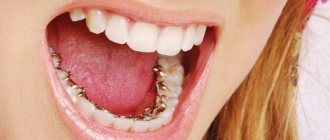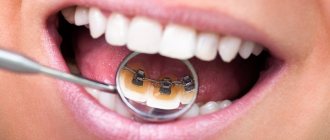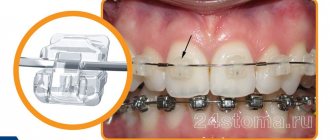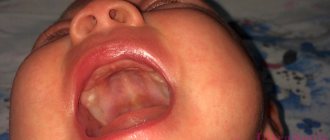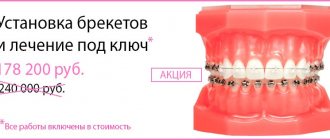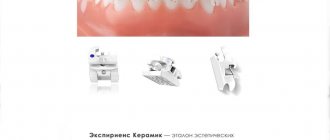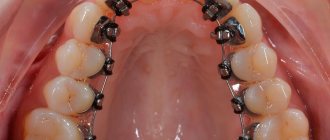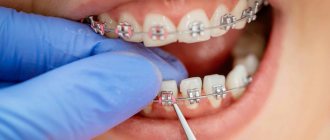Do you know how long it can take to treat a malocclusion with braces? Up to five years! Naturally, not everyone is satisfied with wearing an extraneous, clearly visible and outwardly not very attractive design during all this time. Yes, and in the most visible place. For patients with increased aesthetic requirements, we are ready to offer a special device for correcting malocclusion: invisible braces.
Invisible lingual braces are installed on the inside of the teeth and are therefore only visible when the mouth is opened very wide. And if the treatment of malocclusion with conventional braces can no longer be called some kind of exotic - this method is very common and widely practiced in dental practice, then invisible braces are still considered as a very unusual device.
An alternative to them can only be plastic, ceramic and sapphire braces. But the first ones are not strong and durable enough, and the second and third ones are very expensive. Lingual braces do not suffer from these disadvantages, although they have their own: discomfort in the oral cavity during the adaptation period, diction is impaired in a number of patients - all these problems resolve themselves during the first 2 weeks of wearing the system, following adaptation.
What are lingual braces?
In modern dentistry, there are two main groups of braces: vestibular and lingual. The first ones are installed on the outside of the dentition, so that orthodontic treatment will not remain invisible to others even if spectacular translucent systems are installed. Lingual braces are an orthodontic system that is fixed to the inside of the teeth. This is the main advantage: due to their location, the locks remain completely invisible to prying eyes.
Photos before and after treatment with lingual braces
The photographs below show a mild clinical case where treatment with lingual braces lasted 9 months.
Transparent aligners
Clear aligner trays are made from a variety of materials. They are highly valued both among specialists and consumers. All presented devices are of high quality, efficiency and aesthetics. The main advantage of such systems is elegance and discreetness. And if earlier wearing such elements caused a lot of problems, then with modern products they do not bring any trouble.
The essence of the treatment is that the patient is given an individual set of several mouth guards. While wearing them, the teeth are gradually straightened and a new mouth guard is placed. They can be worn around the clock to speed up the process, taking them off when eating and exercising.
If it is not possible to use mouthguards, unobtrusive braces are installed. This is done in the following cases:
- incorrect position of teeth;
- crowding;
- narrowing of the dental arches;
- malocclusion.
As for contraindications, they also exist. Invisible braces should not be used if there are any inflammatory processes in the mouth or gums. In addition, restrictions include the following factors:
- diseases of the circulatory system;
- presence of cancer;
- any pathologies of the endocrine system, including diabetes;
- active tuberculosis.
It is worth noting that the structure is not installed if there is individual intolerance. In addition, bite correction with transparent aligners is not carried out for children of the younger age group.
Types of lingual braces
Today there are many varieties of internal braces from different manufacturers. The choice of devices is quite large, so everyone can find the best option. All of them effectively help eliminate crooked teeth and cope with malocclusion completely unnoticed by others, but each lingual system has its own characteristics. The devices vary depending on materials, manufacturing technology and cost. Let's look at the most popular invisible lingual braces.
STB
Bracket system from Ormco, USA. It has a round shape and is made of metal. The thickness of STB lingual braces is 1.5 millimeters, while they provide precise correction of the dentition and comfort in use. The model does not have the main disadvantage of conventional lingual appliances - large staples on the side of the tongue. STB lingual braces are quite easy to care for, so they are perfect even for children. The device has virtually no effect on pronunciation.
Incognito
An innovative German brace system made from a platinum-gold alloy is manufactured by Top Service based on an impression of the patient’s teeth: first, a 3D model of the future device is designed, taking into account the smallest nuances of the jaw structure, after which the lingual system is produced by milling using special CAD/CAM technology. Invisible lingual braces Incognito are hypoallergenic and ideal for any clinical case.
Win
Another model produced by Top Service. However, unlike Incognito lingual braces, these internal braces are miniature in size and flattened in shape. Standard Win lingual braces do not cause discomfort while wearing and are practically not felt. The system is ideally adapted to the dental surface and is suitable for eliminating pathologies of any complexity. In addition, the improved production technology of the device has made it possible to significantly reduce the cost of the model in comparison with the Incognito lingual brace system.
2D
Modern invisible braces from the German manufacturer Forestadent. They have a perfectly polished surface and a small thickness, which allows you to maintain diction and maintain wearing comfort. Also, one of the advantages of 2D lingual braces is the price, and in terms of efficiency they are not inferior to other models.
In Ovation L
Lingual metal brace system from one of the largest companies in the dental market, Dentsply. Main advantages: accessibility and versatility. The device is made from an alloy of cobalt and nickel and is sold completely ready, eliminating the need for the patient to wait. The In Ovation L system is suitable for those who will experience tooth movement of up to six millimeters.
Why are braces better than aligners?
Professionals compare the two types of structures in terms of effectiveness, and consumers focus on the cost of treatment. And on both sides, aligners are inferior to braces. However, they still have a significant advantage - if necessary, the structure can be removed independently. It is important to remember that you need to wear aligners at least 22 hours a day. Otherwise, the effectiveness of treatment will be reduced to zero.
The very possibility of removing the caps is fraught with some danger. Patients who remove a mouth guard to eat or brush their teeth in peace often forget to put it back on. It is not uncommon to not want to cause inconvenience to yourself if the aligners cause discomfort or a banal loss of aligners. Due to such negligence, the duration of treatment increases significantly, and its effectiveness drops sharply.
Efficiency
In terms of effectiveness, no design can compare with braces. Although aligners can correct major malocclusions, they are not suitable for correcting severe malocclusions. To understand which type of structure is best to use in your particular case, an in-person consultation with an orthodontist is necessary.
Price
The pursuit of an aesthetic component always threatens to increase the price. Clear confirmation are the aligners. They are more expensive than braces. On average in St. Petersburg, treatment with mouthguards starts from 200 thousand rubles, although exceptions are possible. For example, patients are sometimes offered to order a cheaper case with a limited number of trays. This is not recommended - mouth guards should be made of high-quality material that is hard enough to put pressure on the teeth, but at the same time comfortable to wear. Cheap mouth guards may not meet these requirements. At the same time, it is also impossible to save on the number of trays in the set - treatment must proceed smoothly and consistently, and the “step” of each tray is important. That's why it's better to choose aligners from world leaders in the production of aligners, such as the American Invisalign
Installing lingual braces on teeth
The procedure for installing internal braces is not particularly different from fixing traditional braces. First of all, the patient will undergo a preparatory stage, during which he will undergo diagnostics, professional hygiene procedures and oral sanitation (a set of medical procedures to eliminate diseases and inflammation in the oral cavity).
Based on the diagnostic results, 3D modeling of lingual braces is carried out, after which an orthodontic apparatus is manufactured in the laboratory, taking into account all the anatomical features of the person. The production of the lingual system will take from a month to a month and a half.
When the device is ready, the orthodontist begins installing braces on the inside of the teeth. To install lingual braces, the following manipulations are performed.
- The enamel is polished and treated with a restoring substance.
- Special linings are attached to the inside of the dentition and are connected to each other.
- Special clasps, which are called braces, are secured to the onlays using dental glue. They set the desired direction of movement for each tooth.
- An orthodontic power arch is inserted into the braces, connecting them together.
- The arch is secured to the locks using elastic ligature fasteners (in ligature models) or with special clips located directly on the locks (in non-ligature models).
During treatment with lingual braces, the orthodontist periodically replaces the arches with new, more rigid ones in order to increase the load on the dentition. The period of wearing such a system is on average from one and a half to two years, but it is impossible to say exactly how long lingual braces are worn, because the timing may vary depending on the degree of curvature of the teeth and malocclusion, as well as the characteristics of the patient’s body.
Vestibular ceramic braces
Vestibular braces are any braces that are installed on the front wall of the teeth. Perhaps, in modern orthodontics this type of structure is used most often. However, this does not mean that the choice of a system for correcting occlusion is limited to bulky iron devices.
Braces made of translucent ceramics, the color of which is as close as possible to the shade of your own enamel, have gained high popularity. The material is absolutely safe for the body, does not cause allergies, because it does not contain metal impurities. Ceramics are not stained, so the patient does not have to give up coloring products, coffee and tea, for fear that the locks will darken and become more noticeable over time.
The disadvantages of ceramic brace systems are related to the characteristics of the material - it is more fragile than metal, so the risk of the lock chipping or coming off increases. Such braces require careful care and avoidance of hard products.
In what cases are internal braces not used?
For a number of clinical cases, invisible braces are the best treatment option. For example, lingual braces for deep bites work much more effectively than vestibular braces. However, there are a number of restrictions under which it is better not to place lingual braces on teeth. Among them:
- periodontal diseases;
- low dental crown;
- dysfunction of the temporomandibular joint;
- allergy to the materials from which the system is made;
- bruxism;
- too narrow jaw;
- severe crowding of teeth;
- age under 11 years.
Price
If we consider the price factor, then the price for invisible berects is ambiguous. When compiling it, a number of factors are included. If we talk about the most expensive and elegant products, then sapphire ones, which have a thin platform. Each platform is tailored to the individual tooth shape. Thanks to modern technologies that are actively used for the production of invisible braces, it is possible to obtain high precision, and the effectiveness of therapy can be predicted in the first stages. The cost of invisible braces in Russia is 80,000–15,000 rubles.
Installing braces is a necessary procedure, thanks to which it is possible to solve all problems associated with incorrect teeth and bite. The best option would be to install invisible structures that allow you to feel comfortable both while talking and eating.
Sources used:
- National Library of Medicine (USA)
- "Orthodontics. Textbook for dentists" (Kutsevlyak V.I.)
- Agadzhanyan, E.G. Notes of a good dentist / E.G. Aghajanyan. - M.: Omega, 2011.
Lingual braces and diction
Installing an invisible braces system is the best option in terms of aesthetics. However, many patients complain that after installing lingual braces, their diction deteriorates. When correcting a bite with lingual braces, the patient may actually develop speech defects during the process of getting used to the device, especially when pronouncing sibilant consonants. For braces that are placed from the inside, this is a normal phenomenon; it completely disappears after two to four weeks, after which the patient continues to lead his usual lifestyle.
Disadvantages of invisible braces
Of course, any brace system, even invisible, has its own characteristic disadvantages. These include:
- Inconspicuous braces compared to standard ones can create some problems with diction. But this disadvantage quickly goes away as soon as adaptation ends.
- Technical difficulties when installing an invisible structure. This requires professionalism and extensive experience as a doctor in this field. In addition, the patient will have to be more careful in cleaning and caring for the braces.
- High cost of the product. Among all the available varieties, hidden braces are considered the most expensive.
Which is better: regular or lingual braces?
Compared to vestibular (external) braces, lingual braces have both advantages and several disadvantages:
- Aesthetics: even the most attentive interlocutor will not guess that you are undergoing treatment with lingual braces.
- Comfort: internal dental braces do not cause damage to the lips and cheeks, as they do not come into contact with them.
- Predicted result: the lingual brace system is made on the basis of a 3D model, and the patient can see in advance what his smile will look like at the end of treatment.
- Hypoallergenic: systems consist of alloys that do not cause an allergic reaction.
- The ability to correct even the most difficult case of deep bite.
- Cause increased salivation during the adaptation period.
- They may rub the tongue, especially in the first weeks after installation.
- Diction is impaired (the problem is solved within a couple of weeks).
- They have more limitations compared to the vestibular systems.
- Requires more careful adherence to oral hygiene procedures.
- They have a high cost.
Most of the disadvantages of lingual braces are conditional, since the prices of the devices and their level of comfort vary among different models of lingual braces.
Video about lingual braces
Sapphire invisible braces
Today, invisible dental braces, the manufacture of which involves the use of medical sapphire, have begun to be actively introduced into the process. Such a system not only serves to eliminate problems with malocclusion, but can also become a stylish decoration. The stones are crystal clear, but if light hits them, the stones immediately begin to shimmer.
The fundamental reason that can affect the overall impression remains the arches. But they can be painted white, which makes them invisible. To understand how attractive such orthodontic systems are, it is necessary to properly define their positive qualities:
- They are practically invisible on the teeth and have a very attractive appearance.
- They have high strength, if we draw an analogy with ceramics and plastic.
- There is no violation of diction.
- Sapphire braces do not rub or injure the oral mucosa.
- Invisible sapphire systems allow you to painlessly correct your bite, and the process of getting used to it lasts very quickly.
Although there are so many advantages, sapphire designs can have certain disadvantages. This should include the following:
- High price. Today, not everyone can install such products. It is impossible to accurately determine the cost of such an installation. Here everything depends on the clinic where the braces will be installed, as well as on individual characteristics. The approximate price of the structure will be 80-100 thousand rubles.
- Invisible sapphire systems cause discomfort to the patient in the first days after their installation. But, as practice shows, patients experience discomfort when installing various orthodontic systems.
Is it possible to get lingual braces cheaply?
Many patients are concerned about the question of whether it is possible to fix lingual braces without much damage to their wallet. These are quite expensive devices, most of which are manufactured exclusively for the patient. However, there are options here.
Lingual braces for one jaw
First, it is worth discussing with your orthodontist whether it is possible to install braces on the inside of the teeth on one jaw. This can be in combination with the normal vestibular system or alone in uncomplicated cases. Thus, it is quite possible to install lingual braces on the upper jaw or only on the lower jaw in order to correct the unevenness of only one row of teeth if the patient has the following problems.
- Mild crowding without complications in the anterior jaw.
- Gaps in the front part of the jaw, while the lateral teeth close together correctly.
- Strongly erupted lateral teeth without antagonists.
- Gaps to be closed after tooth extraction.
Partial lingual braces
In some cases, when the patient’s teeth are crooked in a certain place, you can get by with partial lingual braces, which the doctor will fix not on the entire dentition, but only in the area where it is planned to eliminate the local defect. Partial lingual braces with installation will cost the patient almost half as much as a device for the entire dentition.
The final decision on whether it is possible to install a lingual brace system on only one jaw or locally can only be made by the attending physician - taking into account the clinical picture and subject to a stable result.
Budget system models
Another way to save money when installing invisible braces on your teeth is to choose a budget system. The most expensive today are Incognito lingual braces. However, other internal dental braces are no worse in effectiveness than designs from the premium segment. They only differ in the materials of manufacture, the method of fixation and the size of the locks - braces. Table of approximate prices for popular brace systems (for one jaw):
| Bracket system | Cost in rubles |
| STB | from 60 000 |
| Incognito | from 100,000 |
| Win | from 65 000 |
| 2D | from 35 000 |
| In Ovation L | from 25 000 |
In addition to the cost of the braces themselves, the final price of orthodontic treatment will also include diagnosis, installation, regular correction and removal of the lingual brace system. For example, the cost of correcting a malocclusion or crooked teeth using Incognito lingual braces will ultimately cost 300,000 - 400,000 rubles. And if you choose a more budget option, for example, Win or STB lingual braces, then the cost of treatment will be up to 230,000 rubles. So, if you wish, you can install lingual braces inexpensively and become the owner of the smile of your dreams.
Indications and contraindications for bite correction using braces
Braces systems are non-removable orthodontic structures with which dentists correct various pathologies of the dentofacial apparatus.
Wearing braces is indicated in the following situations:
- malocclusion (congenital or acquired);
- crooked or crowded teeth;
- interdental spaces.
Braces therapy can be prescribed from the age of 12 to 13 years, when the full formation of the permanent dentition ends. Sometimes, for special medical reasons, treatment can begin at 9–10 years of age.
There are also contraindications. Braces cannot be installed:
- with a large number of missing elements of the dentition;
- for oncology;
- immune diseases;
- diseases of the blood and skeletal system;
- tuberculosis;
- for serious mental disorders;
- bruxism (teeth grinding).
The presence of indications and prohibitions for brace therapy is identified by an orthodontist at a consultation after examination, medical history and hardware diagnostics. Our clinic has all the necessary equipment to obtain reliable information about each specific clinical case.
Features of care
The hygienic procedure must be carried out at the proper level, and even more so while wearing orthopedic devices such as braces. To thoroughly clean transparent elements, you must use additional products:
- dental brush;
- irrigator;
- mono-tuft toothbrush.
Tooth enamel and the places where braces are attached are thoroughly cleaned with brushes and special brushes, and such procedures must be carried out more often and for longer. After this, you need to rinse your mouth thoroughly to clean hard-to-reach places, since it is in them that food residues often accumulate. Such activities must be carried out after any meal; it is best to do this with solutions that have antiseptic properties.
In addition, it is worth reviewing and adjusting your diet, eliminating from it foods that can stain your braces. Avoid seeds, nuts, crackers and other solid foods while wearing them. It is also extremely undesirable to eat too hot or, conversely, cold foods. The fact is that sudden changes in temperature that occur in the oral cavity negatively affect dental appliances, after which they cease to function normally.
It should be added that an effective result in the form of a beautiful smile can only be obtained if a specialist professionally installed braces and the patient strictly followed all his recommendations.

